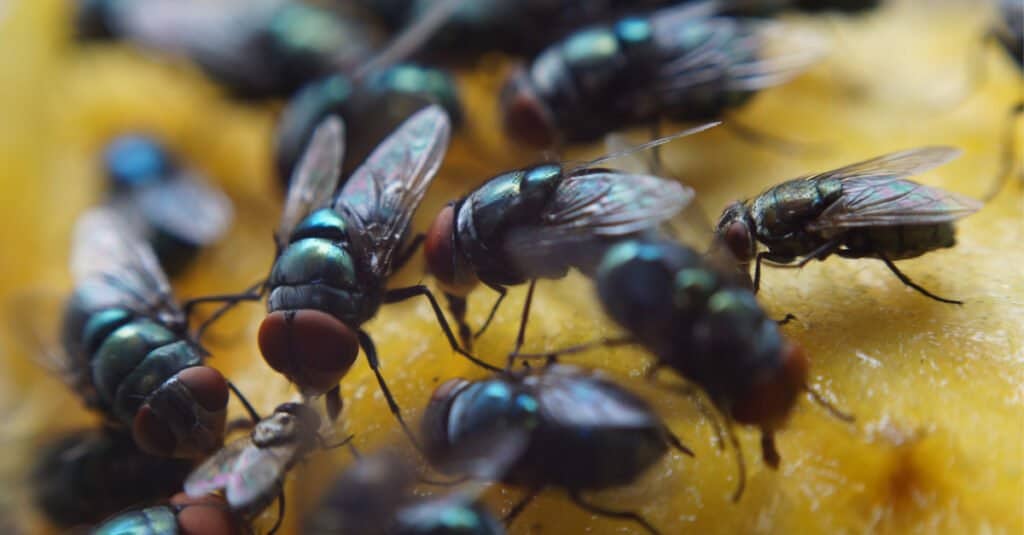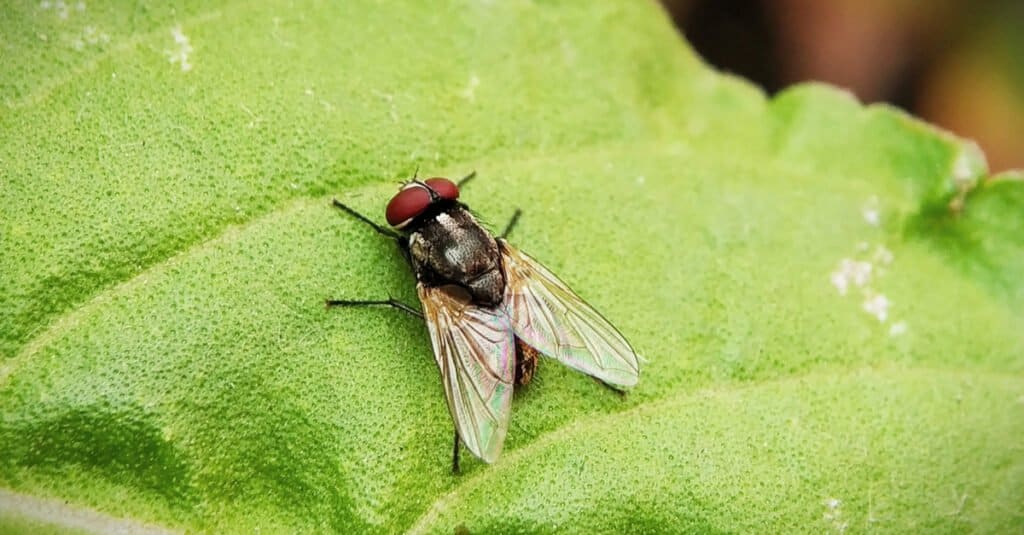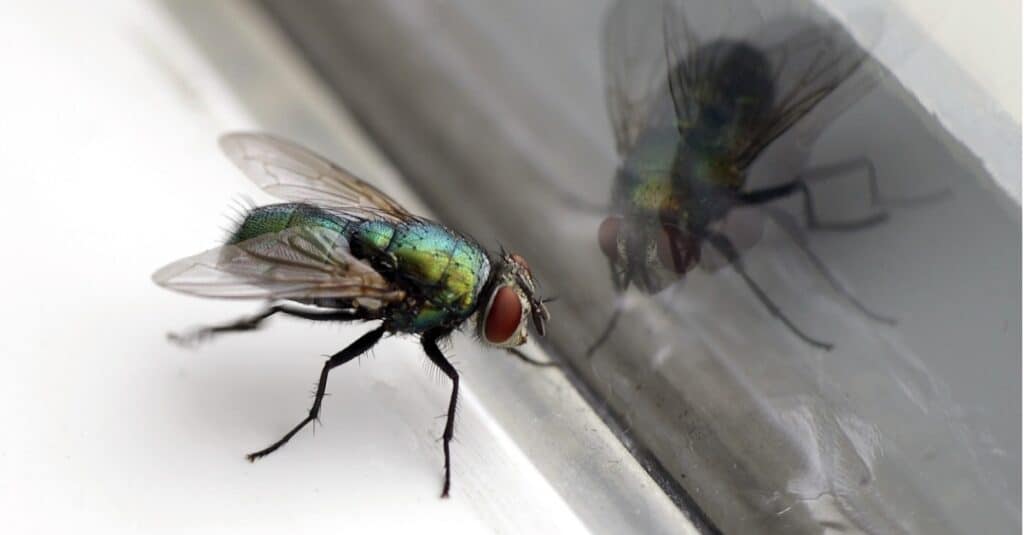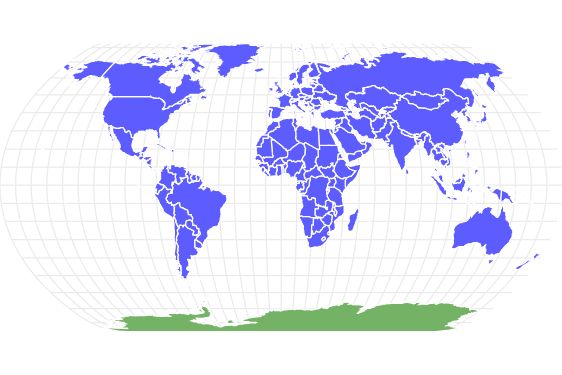Housefly
Musca domestica
The fly has no teeth
Advertisement
Housefly Scientific Classification
- Kingdom
- Animalia
- Phylum
- Arthropoda
- Class
- Insecta
- Order
- Diptera
- Family
- Muscidae
- Genus
- Musca
- Scientific Name
- Musca domestica
Read our Complete Guide to Classification of Animals.
Housefly Conservation Status
Housefly Facts
- Name Of Young
- Larvea
- Group Behavior
- Solitary
- Fun Fact
- The fly has no teeth
- Most Distinctive Feature
- Limbs are used to taste food; eyes
- Gestation Period
- one day
- Habitat
- Every- and anywhere
- Predators
- Frogs, spiders, mites, birds
- Diet
- Omnivore
- Type
- insect
- Common Name
- fly
- Number Of Species
- 109998
- Group
- insecta
View all of the Housefly images!

“Houseflies can walk upside down.”
Up there with the cockroach, the housefly is one of the world’s most annoying insects. Nearly 90 percent of all species invading our habitats are houseflies. They survive on a diet of decomposing garbage and organic waste. Flies are one of the filthiest creatures on the planet, carrying millions of disease-infested microorganisms over their lifespan.
5 Incredible Housefly Facts!

©iStock.com/reyborfrla
- The insect tastes with its limbs. They have chemonsensilla (taste receptors) on the lower legs and feet. Landing on a potential meal, whether a sandwich on your kitchen counter or animal feces in the street, the fly wanders on the surface so that their limbs get a taste. Satisfied, the housefly gladly consumes its meal.
- The insect is capable of spreading a wide array of diseases. That’s due to breeding and feeding habits that bring them in contact with a broad range of bacteria over their life cycle, including E.coli, and Salmonella, as well as skin and eye infections and diarrhoeal diseases. The housefly spreads these threats through contamination of everything they come in contact with, including cooking utensils, food, and skin.
- The bugs have a morphology that lets them climb and walk on any surface vertically, horizontally, or upside down. Each foot has a pair of pads (called pulvilli) with tiny hairs. The characteristic produces a sticky substance that provides an excellent grip, letting the insect scale almost anything.
- Flies can see in nearly 360-degree surround. That’s to the side, up, down, and behind themselves. The eyes don’t move because of its spherical protrusion and shape. Unlike humans, the creature has compound eyes. The feature allows them to view in all directions which is how they so quickly react to perceived disturbances with great speed.
- Even their breeding habits are disgusting. We rush expecting mothers to the cleanest environment we can find for birthing. Flies happily lay their eggs in rotting carcasses, feces, garbage or other undesirable elements. There’s a method to the horrendous. Those environments provide birthing maggots with something to diet on after the gestation period.
Evolution and Origins
Originally hailing from the steppes of central Asia, this ubiquitous fly has since spread to every inhabited continent, thriving in diverse climates spanning from tropical to temperate. It has successfully adapted to a wide range of environments, encompassing both rural and urban settings.
According to research, it is believed that house flies (Musca domestica) likely originated in the Middle East. They have a remarkable history, dating back at least 65 million years.
Some sources even suggest that house flies may have arrived in the Americas alongside or possibly even before Columbus, potentially with individuals such as Brendan the Irish monk around AD 550.
Species, Types, and Scientific Names

The housefly has spread all over the world as a commensal of humans. It is the most common fly species found in houses.
©Fotopstryk/Shutterstock.com
The housefly lives close to people. They feed on waste and foodstuff wherever they find it in a habitat, transporting various disease agents along the way with speed.
All species in the Musca domestic family adapt to human cohabitation. They have another thing in common: they’re threats to our health.
Over its life cycle, the fly is a spreader of varying infections. Science links blowflies to enteric infection transmission. That includes diarrhea, dysentery, typhoid, and cholera. Other health concerns fly brings to the table are trachoma and epidemic conjunctivitis (eye infections), cutaneous diphtheria, yaws, leprosy, and mycoses (skin diseases).
Here are some of the more common species of the housefly.
Filth Flies
Filth fly is the actual term used for the entire spectrum of flies, for all the obvious reasons.
Large Filth Flies
Common Housefly
The common housefly goes after your food and insists on flying around your face when you’re trying to rest. The insects search for food and waste not just for eating but to lay eggs. There isn’t any part of the world where these annoyances aren’t invading sewers, trashcans, carrions, or feces.
Blow Flies
Known also as bottle flies, the blowfly generates its offspring in rotting meat or carrion. Two of the most common bugs here are the blue bottle fly and the black blowfly. If you see these critters that likely means you have some type of animal carcass in the walls, attic, or basement
Small Filth Flies
Drain Fly
Mistaken often for a smaller housefly, the drain fly is unique unto itself with its moth-like or furry appearance. The creature prefers sink drains and unused garbage disposals. They drop eggs in the built-up sludge in pipes. Pest control can be problematic as breeding sites can be hard to reach.
Lesser Housefly
The lesser version of flies is noted for being about two-thirds the size of its cousin. The pests create the same problems on a big scale throughout their lifespan.
Fruit Fly
Fruit flies live in drain lines, or any source of moisture such as, say, a dirty garbage can. In your kitchen, they go for a diet of soda, vinegar, or overripe produce juice. The fruit fly gets into liquids and sticky syrups, contaminating them. Their invasions take place pretty much in the summer and fall. But they can occur any time of the year if the flies can find sound reproductive sites and suitable food sources.
Cluster Flies
Cluster flies are larger than the common type. They claw to get indoors during autumn to get out of the cold. Once inside, the pests proceed to populate spaces. Growing in numbers, they settle in walls and attics. Once things warm up, they will look for an escape. The critters infest your home while desperately searching for a way out.
Stable Fly
The stable fly is an animal found almost anywhere you might come across another animal. The insect is a bloodsucker. Unable to find animals, they will attack pets and humans. The aggravating creatures are also called dog flies (canines are easy prey) and biting flies (they resemble the common species).
Appearance: How to Identify Them

©IamBijayaKumar/Shutterstock.com
Let’s take a look at the morphology of these insects.
- Flies are typically gray or black with four longitudinal stripes on the thorax. The bodies are slightly hairy and oval. They take to the air via a pair of membranous wings. Flies have six legs and antennae.
- Adults are between one-eighth and one-quarter inches long. Females are generally bigger than males. Flies tend to have a weight between 0.00007 and 0.0016 ounces.
- The pests have red, compound eyes. Overall, arthropods have compound eyes. Crustaceans and insects with compound eyes have poor image resolution but also have a wide range of views. The feature lets flies detect movement from most directions and react with great speed.
Habitat: Where to Find the Them

Tsetse flies are found in
Africa
, living in damp areas along the banks of rivers and lakes. They are the size of a large housefly and feed only on blood.
©Jaco Visser/Shutterstock.com
There is almost no environment the housefly can’t adapt to.
During the gestation period, larvae live on moisture so flies lay eggs wherever they find it. Some species use ponds, lakes, marshes, swamps, and birdbaths.
Believe it or don’t, these nasty bugs use their 28-day lifespan to better the earth. They’re considered beneficial to nature as decomposers of decaying and dead organisms. Flies are critical to the food chain, serving as meals for reptiles, birds, fish, and even certain plants.
Diet: What Do Flies Eat?
The housefly gnaws at almost anything — the food you leave on your plate, carrion, fecal matter, spills, etc. The insect has no teeth. The animal uses its sponging mouth to liquefy meals, regurgitating the substance before ingesting it.
They’re attracted to a wide array of substances such as the following:
- Overripe vegetables and fruit
- Feces
- Sugary and syrupy substances
- Liquids of all types
- Meat
- Carrions
What Eats the Housefly
The most famous housefly predator is the frog. Who hasn’t seen the image of a frog flicking its tongue to catch one of these unsuspecting bugs? There’s also the spider who traps flies in webs.
Many creatures eat fly larvae, including fowl, mites, wasps, and crickets. Some animals attracted to the same vegetables and fruits that draw in flies, will chow down on the larvae in them. Some animals also eat pupae beneath trees.
Prevention: How to Get Rid of Flies

housefly on window pane
©iStock.com/photointrigue
Here are tips for dealing with flies and pest control, putting an end to their lifespan.
- Certain flowers and herbs chase flies away. Plant basil, lavender, catnip, bay leaves, and marigold in your garden and around the property.
- Light traps capture flies or kill them with a zap. Keep the instruments hung high, at least five feet off the floor.
- A mix of dish soap and vinegar is another deterrent to trap flies. You need a few drops of soap and an inch of apple cider vinegar. Cover the glass with plastic wrap and a rubber band. Poke holes in the wrap. Flies will enter and can’t lift their weight if they land on the liquid.
- Venus flytraps, planted outside, will eat the insects.
- Insecticides, traps, and repellants come in a variety of options. Flies can develop an immunity to most products though. Be sure to buy indoor usage only and ventilate well after applying.
- Sticky traps are popular resources. Place them around the house. Drawn to sticky surfaces, flies will go to the devices.
- If the situation is unbearable, reach out to a local exterminator.
Housefly FAQs (Frequently Asked Questions)
Are houseflies dangerous?
Yes. Throughout the life cycle, they are carriers of untold bacteria. Some species bite to get blood beneath the skin.
How many legs does a housefly have?
All species of flies have a half dozen legs.
How do you identify the housefly?
The morphology sees flies as small dark creatures with protruding eyes. They have six legs, oval bodies, antennae, and membranous wings.
How do you get rid of the housefly?
You can use organic methods, pesticides, or exterminators for pest control. Let the severity of the infestation guide you.
What is the difference between a housefly and a horsefly?
There are multiple key differences between horseflies vs houseflies. Female horseflies need blood to obtain the protein necessary for them to reproduce, and she is relentless in her pursuit. A way to tell a horsefly from a housefly is that a female horsefly will actively chase you!
Do houseflies poop?
Yes, houseflies poop.
Thank you for reading! Have some feedback for us? Contact the AZ Animals editorial team.















